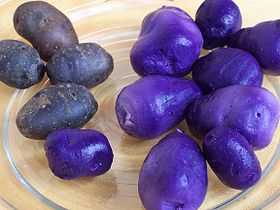Vitelotte


Vitelotte, also called Vitelotte noire, Négresse[1] or Truffe de Chine,[2] is a gourmet French variety of blue-violet potato.[3] It has been cultivated in France since the early 19th century.
Description
Vitelotte potatoes have a dark blue, almost black, skin and dark violet-blue flesh; they have a characteristic nutty flavour and smell of chestnuts. The colour is retained in cooking, and is due to natural pigments in the anthocyanin group of flavonoids.[4] The plants mature late and, compared to modern varieties, are relatively low-yielding. The tubers are elongated with sunken eyes;[2] they are thick-skinned, and thus keep well.
Etymology
The French word vitelotte derives from the archaic French: vit, meaning "penis" (modern French bite), by analogy with the shape of the tuber. The first occurrence of the word is from 1812.[5]
History
In early descriptions, vitelotte were not necessarily violet-coloured. In a source from 1817, six varieties of potato are listed as available at the market of Les Halles; among them are both vitelotte and violette ("violet").[6] A treatise on agriculture published in 1863 lists five possible colours for the vitelotte: white, yellow, pink, red and violet.[7] In 1873 Alexandre Dumas wrote in his Grand dictionnaire de cuisine:[8]
"... the best of all are unquestionably the violet [ones], preferable even to the red [ones], [and] known in Paris by the name of Vitelottes'"
Gallery
<gallery caption= widths="180px" perrow="4"> File:PurplePeruvianPotatoes.jpg|Vitelotte potatoes File:Pic3.Vitelotte.jpg|Vitelotte potatoes, whole and halved File:Blaue Chips Schüssel.jpg|Crisps made with Vitelotte potatoes|alt=Purple potato crisps File:Vitelotte-potato-leaves.jpg|The leaves and stalks may also show violet colouring </gallery>
References
- ↑ Diehl, Robert (1938). La pomme de terre: caractères et description des variétés (PDF) (in French). Paris: Imprimerie nationale. p. 150.
- ↑ 2.0 2.1 Vitelotte Noire, Négresse (in French). Le Plant Français de Pomme de Terre. Accessed May 2013
- ↑ [s.n.] (2008) The potato. International Year of the Potato Secretariat, Food and Agriculture Organization of the United Nations. Accessed May 2013.
- ↑ Silke Hillebrand, Heike Naumann, Nina Kitzinski, Nils Köhler, Peter Winterhalter (2009) Isolation and Characterization of Anthocyanins from Blue-fleshed Potatoes (Solanum tuberosum L.). Institute of Food Chemistry, Technische Universität Braunschweig, Braunschweig, Germany. Accessed May 2013.
- ↑ Vitelotte (in French). Centre National de Ressources Textuelles et Lexicales. Accessed May 2013.
- ↑ [s.n.] (1817) Mémoires d'agriculture, d'économie rurale et domestique; publiés par la Société royale et centrale d'agriculture (in French). Paris: Librairie de Madame Huzard. p. 508.
- ↑ Jean Pierre Louis Girardin, Alphonse Du Breuil (1863) Traité élémentaire d'agriculture, Volume 2 (in French). Bibliothèque de la ferme et des maisons de campagne. Paris: Garnier frères. p. 7–11.
- ↑ Alexandre Dumas (1873) Grand dictionnaire de cuisine (in French). Paris: Alphonse Lemerre. p. 847.
"… les meilleures de toutes sont sans contredit, les violettes, préférables mêmes aux rouges, connues à Paris sous le nom de Vitelottes"
| Wikimedia Commons has media related to Vitelotte. |